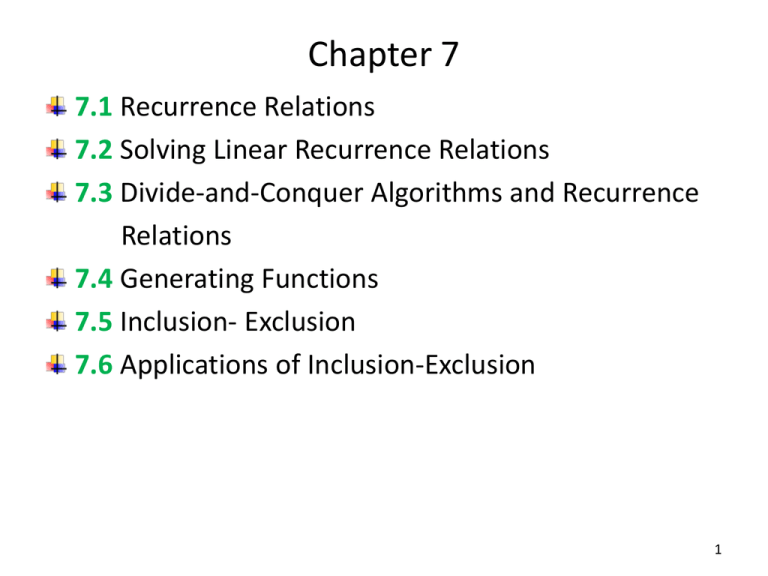
Chapter 7
7.1 Recurrence Relations
7.2 Solving Linear Recurrence Relations
7.3 Divide-and-Conquer Algorithms and Recurrence
Relations
7.4 Generating Functions
7.5 Inclusion- Exclusion
7.6 Applications of Inclusion-Exclusion
1
7.1 Recurrence Relations
• Recurrence Relations
• Modeling with Recurrence Relations
2
Recurrence Relations
• The number of bacteria in a colony doubles every
hour. If a colony begins with five bacteria , how many
will be present in n hours?
• Some of the counting problems that cannot be
solved using the techniques discussed in Chapter 5
can be solved by finding relationships, called
recurrence relations.
• We will study variety of counting problems that can
be modeled using recurrence relations.
• We will develop methods in this section and in
Section 7.2 for finding explicit formulae for the terms
of sequences that satisfy certain types of recurrence
relations.
3
Recurrence Relations
• Example 1: Let {an} be a sequence that satisfies the
recurrence relation an = an-1 – an-2 for n=2, 3, 4, . . .
And suppose that a0= 3 and a1= 5.
What are a2 and a3 ?
• Example 2: Determine whether the sequence {an},
where an=3n for every nonnegative integer n, is a
solution of the recurrence relation an=2an-1 –an-2 for
n=2, 3, 4, . . ., Answer the same question where an=
2n and where an= 5?
4
Modeling with Recurrence Relations
• Example 3: Compound Interest
Suppose that person
deposits $10,000 in a savings account at a bank yielding
11% per year with interest compounded annually.
• How much sill be in the account after 30 year?
•
•
•
•
Solution: Pn = Pn-1 +0.11Pn-1 = (1.11)Pn-1
P1 = (1.11)P0
P2 = (1.11) p1=(1.11)2 p0
P3 = (1.11) P2=(1.11)3 P0
:
• Pn = (1.11) Pn-1=(1.11)n P0
• Inserting n =30 into the formula Pn =(1.11)n 10,000 shows that
after 30 year the account contains
• P30 = (1.11)3010,000=$228,922.97
5
Modeling with Recurrence Relations
• Example 4: Rabbits and the Fibonacci Numbers
consider this problem, which was originally posed by
Leonardo Pisano, also Known as Fibonacci, in the
thirteenth century in his book Liber abaci. A young
pair of rabbits ( one of each sex) is placed on n island.
• A pair of rabbits does not breed until they are 2
months old. After they are 2 months old, each pair of
rabbits produces another pair each month, as shown
in Figure 1.
• Find a recurrence relation for the number of pairs of
rabbits on the island after n months, assuming that
no rabbits ever die.
6
Modeling with Recurrence Relations
FIGURE 1 Rabbits on an Island.
• Consequently, the sequence {fn} satisfies the
recurrence relation
fn =fn-1 + fn-2 ; f1=1, f2=1
7
Modeling with Recurrence Relations
• Example 5: The Tower of Hanoi A popular puzzle of the late
nineteenth century invented by the French mathematician
Édouard Lucas, called the Tower of Hanoi, consists of three
pegs mounted on a board together with disks of different
sizes. Initially there disks are placed on the first peg in order
of size, with the largest on the bottom ( as shown in Figure 2).
• The rules of the puzzle allow disks to be moved one at a time
from one peg to another as long as a disk is never placed on
the top of a smaller disk.
• The goal of the puzzle is to have all the disks on the second
peg in order of size, with the largest on the bottom.
• Let {Hn} denote the number of moves needed to solve the
Tower of Hanoi problem with n disks. Set up a recurrence
relation for the sequence {Hn}
8
Modeling with Recurrence Relations
FIGURE 2 The Initial
Position in the Tower of
Hanoi.
FIGURE 3 An Intermediate
Position in the Tower of Hanoi.
9
Modeling with Recurrence Relations
• Example 6: Find a recurrence relation and give initial
conditions for the number of bit strings of length n
that do not have two consecutive 0s. How many
such bit strings are there of length five?
• Example 7: Codeword Enumeration A computer
system considers a string of decimal digits a valid
codeword if it contains an even number of 0 digits.
For instance, 1230407869 is valid, whereas
120987045608 is not valid. Let an be the number of
valid n-digit codewords. Find a recurrence relation
for an.
10
Modeling with Recurrence Relations
• Example 8: Find a recurrence relation for Cn , the
number of ways to parenthesize the product of n+1
numbers, x0.x1.x2.. . ..xn , to specify the order
of multiplication. For example ,C3=5 because there
are five ways to parenthesize x0.x1.x2.x3 to
determine the order of multiplication:
• ((x0.x1) .x2) .x3
• (x0.(x1 .x2)).x3
• (x0.x1) .(x2 .x3)
• x0.((x1 .x2) .x3 )
• x0.(x1 .(x2.x3))
11
7.2 Solving Linear Recurrence Relations
• Some of these recurrence relations can be solved
using iteration or some other ad hoc technique.
• However, one important class of recurrence relations
can be explicitly solved in a systematic way. These
are recurrence relations that express the terms of a
sequence as linear combinations of previous terms.
• Definition 1: A linear homogeneous recurrence
relation of degree k with constant coefficients is a
recurrence relation of the form
an= c1an-1 + c2an-2+ . . .+ ckan-k
Where c1, c2, . . .,ck are real numbers, ck ≠ 0.
12
Solving Linear Recurrence Relations
• The recurrence relation in the definition is linear because
the right-hand side is a sum of previous terms of the
sequence each multiplied by a function of n.
• The recurrence relation is homogeneous because no
terms occur that are not multiples of the ajs.
• The coefficients of the terms of the sequence are all
constants, rather than functions that depend on n.
• The degree is k because an is expressed in terms of the
previous k terms of the sequence.
• A consequence of the second principle of mathematical
induction is that a sequence satisfying the recurrence
relation in the definition is uniquely determined by this
recurrence relation and the k initial conditions
a0 =C0, a1=C1,. . . , ak-1=Ck-1
13
Solving Linear Recurrence Relations
• Example 1: the recurrence relation Pn=(1.11)Pn-1 is a
linear homogeneous recurrence relation of degree
one.
• The recurrence relation fn=fn-1 +fn-2 is a linear
homogeneous recurrence relation of degree two.
• The recurrence relation an=an-5 is a linear
homogeneous recurrence relation of degree five.
• Example 2: The recurrence relation an= an-1+an-22
is not linear. The recurrence relation Hn = 2Hn-1 +1
is not homogeneous. The recurrence relation
Bn =nBn-1 does not have constant coefficients.
14
Solving Linear Homogeneous Recurrence
Relations with Constant Coefficients
• Theorem 1: let c1 and c2 be real numbers. Suppose
that r2-c1r-c2=0 has two distinct roots r1 and r2.
• Then the sequence {an} is a solution of the
recurrence relation an = c1an-1 + c2an-2 if and only is
an = α1r1n + α2r2n for n=0, 1, 2,. . .,where α1 and α2
are constants
15
Solving Linear Homogeneous Recurrence
Relations with Constant Coefficients
• Example 3: what is the solution of the recurrence
relation of the recurrence relation
an = an-1 + 2an-2
With a0= 2 and a1= 7 ?
• Example 4: Find an explicit formula for the Fibonacci
numbers.
fn 1(
1
5
2
) 2(
n
1
5
)
n
2
16
Solving Linear Homogeneous Recurrence
Relations with Constant Coefficients
• Theorem 2: Let c1 and c2 be real numbers with c2 ≠0.
Suppose that r2 - c1r - c2 = 0 has only one root r0.
• A sequence {an} is a solution of the recurrence
relation
an = c1an-1 + c2an-2
if and only if
an= α1r0n+ α2nr0n
for n=0, 1, 2,. . .,where α1 and α2 are constants.
• Example 5: What is the solution of the recurrence
relation an = 6 an-1-9 an-2 ,with a0= 1 and a1= 6?
17
Solving Linear Homogeneous Recurrence
Relations with Constant Coefficients
• Theorem 3: Let c1 , c2 ,. . ., ck be real numbers.
Suppose that the characteristic equation
rk - c1rk-1 - . . . - ck = 0
has k distinct roots r1, r2,. . .,rk. Then a sequence {an}
is a solution of the recurrence relation
an = c1an-1 + c2an-2 +. . . + ckan-k
if and only is
an = α1r1n + α2r2n +. . .+ αkrkn
for n=0, 1, 2,. . .,where α1, α2 , . . ., αk are constants.
18
Solving Linear Homogeneous Recurrence
Relations with Constant Coefficients
• Example 6: Find the solution to the recurrence
relation
an = 6an-1 - 11an-2 + 6an-3
With the initial conditions a0=2 and a1=5, and a2=15.
19
Solving Linear Homogeneous Recurrence
Relations with Constant Coefficients
• Theorem 4: Let c1 , c2 ,. . ., ck be real numbers. Suppose
that the characteristic equation
rk-c1rk-1-. . .- ck= 0
has t distinct roots r1, r2,. . .,rt with multiplicities m1,
m2,. . .,mt , respectively, so that mi ≧ 1 for
i= 1, 2,. . ., t and m1+ m2+. . .+mt =k. Then a sequence {an}
is a solution of the recurrence relation
an=c1an-1+c2an-2 +. . . +ckan-k
if and only if
an= ( α1 , 0+ α1, 1n +. . .+ α1, m1-1nm1-1) r1n
+ ( α2 , 0+ α2 , 1n +. . .+ α2, m2-1nm2-1) r2n
+ … +( αt , 0 + αt , 1n +. . .+ αt, mt-1nmt-1) rtn
for n=0, 1, 2,. . .,where α1, α2 , . . ., αk are constants
20
Solving Linear Homogeneous Recurrence
Relations with Constant Coefficients
• Example 7: Suppose that the roots of the
characteristic equation of a linear homogeneous
recurrence relation are 2, 2, 2, 5, 5, and 9 (that is,
there are three roots, the root 2 with multiplicity
three, the root 5 with multiplicity two, and the root 9
with multiplicity one).
• What is the form of the general solution?
• Example 8: Find the solution to the recurrence
relation
an = -3an-1 - 3an-2 - an-3
With the initial conditions a0=1 and a1=-2, and a2=-1.
21
Linear Nonhomogeneous Recurrence Relations
with Constant Coefficients
• Linear nonhomogeneous recurrence relation with
constant coefficients,
an = c1an-1 + c2an-2 +. . . + ckan-k + F(n)
Where c1 , c2 ,. . ., ck be real numbers and F(n) is a
function not identically zero depending only on n.
• The recurrence relation
an = c1an-1 + c2an-2 +. . . + ckan-k
is called the associated homogeneous recurrence
relation.
22
Linear Nonhomogeneous Recurrence Relations
with Constant Coefficients
• Example 9: Each of the recurrence relations
an = an-1 + 2n , an = an-1 + an-2 +n2+ n +1 , an = 3an-1 +n3n
an = an-1 + an-2 + an-3 + n! , is a linear nonhomogeneous
recurrence relation with constant coefficients. The
associated linear homogeneous recurrence relations
are
an = an-1 ,
an = an-1 + an-2 ,
an = 3an-1
an = an-1 + an-2 + an-3
,respectively.
23
Linear Nonhomogeneous Recurrence Relations
with Constant Coefficients
• Theorem 5: if {an(p)} is a particular solution of the
nonhomogeneous linear recurrence relation with
constant coefficients
an = c1an-1 + c2an-2 +. . . + ckan-k + F(n)
Then every solution is of the form {an(p)+ an(h) } ,
where {an(h)} is a solution of the associated
homogeneous recurrence relation
an = c1an-1 + c2an-2 +. . . + ckan-k
24
Linear Nonhomogeneous Recurrence Relations
with Constant Coefficients
• Example 10: Find all solutions of the recurrence
relation an = 3an-1 + 2n.
• What is the solution with a1= 3?
• Example 11: Find all solution of the recurrence
relation an =5an-1 - 6an-2 + 7n
25
Linear Nonhomogeneous Recurrence Relations
with Constant Coefficients
• Theorem 6: Suppose {an} satisfies the linear nonhomogeneous
recurrence relation
an = c1an-1 + c2an-2 +. . . + ckan-k + F(n)
Where c1 , c2 ,. . ., ck be real numbers and
F(n) = (b1nt + bt-1nt-1 +. . .+ b1n + b0 )*sn
Where b1 , b2 ,. . ., bt and s are real numbers. When s is not a
root of the characteristic equation of the associated linear
homogeneous recurrence relation, there is a particular
solution of the form
(p1nt + pt-1nt-1 +. . .+ p1n + p0 )*sn
When s is a root of this characteristic equation and its
multiplicity is m, there is a particular solution of the form
nm (p1nt + pt-1nt-1 +. . .+ p1n + p0 )*sn
26
Linear Nonhomogeneous Recurrence Relations
with Constant Coefficients
• Example 12: What form does a particular solution fo
the linear nonhomogeneous recurrence relation
an = 6an-1 - 9an-2 + F(n) have F(n) = 3n , F(n) =
n22n ,and F(n) = (n2 +1)3n ?
27
7.3 Divide-and-Conquer Algorithms and
Recurrence Relations
• If f(n) represents the number of operations required
to solve the problem of size n, it follow that f satisfies
the recurrence relation
f(n) = af(n/b) + g(n)
this is called a divide-and-conquer algorithms and
recurrence relations
• Example 1: Binary Search We introduced a binary
search algorithm in section 3.1 .
28
The binary search
• Algorithm 3: the binary search algorithm
Procedure binary search (x: integer, a1, a2, …,an: increasing
integers)
i :=1 { i is left endpoint of search interval}
j :=n { j is right endpoint of search interval}
While i < j
begin
m := (i + j) / 2
if x > am then i := m+1
else j := m
end
If x = ai then location := i
else location :=0
{location is the subscript of the term equal to x, or 0 if x is not
found}
29
Divide-and-Conquer Algorithms and Recurrence
Relations
• Example 3: Merge Sort
• Algorithm 9 A Recursive Merge Sort.
Procedure mergesort(L = a1, . . . , an)
If n > 1 then
m := n/ 2
L1 := a1, a2, . . . ,am
L2 := am+1, am+2, . . ., an
L := merge (mergesort(L1), mergesort(L2))
{L is now sorted into elements in nondecreasing order}
30
Divide-and-Conquer Algorithms and Recurrence
Relations
• Example 4: Fast Multiplication of Integers
• There are more efficient algorithms than the conventional
algorithm (described in section 3.6) for multiplying integers.
• Suppose that a and b are integers with binary expansions of
length 2n.
• Let a = (a2n-1 a2n-2 . . . a1 a0)2 ,b = (a2n-1 a2n-2 . . . a1 a0)2
• Let a = 2nA1 + A0 , b = 2nB1 + B0
A1= (a2n-1 . . . an+1 an)2 , A0= (an-1 . . . a1 a0)2,
B1 = (b2n-1 . . . bn+1 bn)2 , B0= (bn-1 . . . b1 b0)2 ,
• the algorithm for fast multiplication of integers is based on the
fact that ab can be rewritten as
• ab= (22n+2n) A1 B1 + 2n(A1 - A0) (B0 - B1 ) +(2n +1)A0B0 .
31
Divide-and-Conquer Algorithms and Recurrence
Relations
• This shows that if f(n) is the total number of bit
operations needed to multiply two n-bit integers,
then f(2n) = 3f(n) + Cn
• This reasoning behind this equation is as follows.
• The three multiplications of n-bit integers are carried
out using 3f(n)-bit operations.
32
Divide-and-Conquer Algorithms and Recurrence
Relations
• Theorem 1: let f be an increasing function that
satisfies the recurrence relation f(n)= af(n/b) + c
• Whenever n is divisible by b, where a≧1 ,b is an
integer greater than 1, and c is a positive real
number . Then
f(n) is O(nlogb a) if a >1 , O(log n) if a =1
• when n=bk ,where k is a positive integer,
f(n) = C1nlogba +C2 = C1ak +C2
where C1= f(1)+c/(a-1) and C2 = -c/(a-1).
33
Divide-and-Conquer Algorithms and Recurrence
Relations
• Example 6: Let f(n) = 5f(n/2) + 3 and f(1) =7.
Find f(2k), where k is a positive integer. Also ,
estimate f(n) if f is an increase function.
• Example 7: Estimate the number of comparisons
used by a binary search. f(n) = f(n/2) + 2.
• Example 8: Estimate the number of comparisons
used to locate the maximum and minimum elements
in a sequence using the algorithm given in example 2.
f(n) = 2f(n/2) + 2.
34
Divide-and-Conquer Algorithms and Recurrence
Relations
• Theorem 2: Master Theorem Let f be an increasing
function that satisfies the recurrence relation
f(n)= af(n/b) + cnd
Whenever n=bk, where k is a positive integer, a≧1,
b is an integer greater than 1, and c and d are real
numbers with c positive and d nonnegative. Then
f(n) is O(nd)
if a < bd ,
O(nd log n) if a= bd ,
O(n logba) if a > bd .
35
Divide-and-Conquer Algorithms and Recurrence
Relations
• Example 9: Complexity of Merge Sort In Example 3
we explained that the number of comparisons used
by the merge sort to sort a list of n elements is less
than M(n), where M(n)=2 M(n/2) +n . By the Master
Theorem (Theorem 2) we find that M(n) is O(n logn) ,
which agrees with the estimate found in section 4.4.
• Example 10: Estimate the number of bit operations
needed to multiply two n-bit integers using the fast
multiplication algorithm described in Example 4.
36
Divide-and-Conquer Algorithms and Recurrence
Relations
• Example 11 : Estimate the number of multiplications
and additions required to multiply two n x n matrices
using the matrix multiplication algorithm referred to
in example 5. The function for the number of
multiplications and additions is f(n)=7f(n/2)+(15/4)n2.
37
Divide-and-Conquer Algorithms and Recurrence
Relations
• Example 12: The Closest-Pair Problem Consider the
problem of determining the closest pair of points in a
set of n points (x1,y2),. . ., (xn,yn) in the plane, where
the distance between two points (xi,yi) and (xj,yj) is
the usual Euclidean distance [ (xi -xj)2+ (yi - yj)2 ]0.5.
• This problem arises in many applications such as
determining the closest pair of airplanes in the air
space at a particular altitude being managed by an
air traffic controller.
• How can this closest pair of points be found in an
efficient way? (FIGURE 1 )
38
Divide-and-Conquer Algorithms and Recurrence
Relations
FIGURE 1 The Recursive Step of the Algorithm for Solving the
Closest-Pair Problem.
39
Divide-and-Conquer Algorithms and Recurrence
Relations
FIGURE 2 Showing That There Are at Most Seven Other Points to
Consider for Each Point in the Strip.
40
7.4 Generating Functions
• Definition 1: The generation function for the
sequence a0, a1, . . .,ak ,. . . of real numbers is the
infinite series
• G(x) = a0+ a1 x + . . .+ akxk +. . . =k=0 akxk
• Example 1: The generating functions for the
sequences {ak} with ak=3 , ak=k+1, and ak= 2k are
k=0 3xk ,k=0 (k+1)xk ,and k=0 2kxk ,respectively.
• Example 2: what is the generating function for the
sequence 1, 1, 1, 1, 1, 1?
41
Useful Facts About Power Series
• Example 3: Let m be a positive integer. Let ak= C(m,k),
for k=0, 1, 2,. . . m,. What is the generating function
for the sequence a0, a1, . . .,am?
• Example 4: The function f(x)=1/(1-x) is the generating
function of the sequence 1, 1, 1, 1,. . ., because
1/(1-x)= 1 + x + x2+. . . . for |x|<1.
• Example 5: The function f(x)=1/(1-ax) is the
generating function of the sequence 1, a, a2, a3, . . .
because 1/(1-ax)=1 + ax + a2x2 + . . .
when |ax|<1, or equivalently, for |x|<1/|a| for |a|≠ 0
42
Useful Facts About Power Series
• Theorem 1: Let f(x)= k=0 akxk and g(x)= k=0 bkxk .
• Then f(x)+ g(x)= k=0 (ak + bk )xk and
• f (x)g(x) = k=0 j=0k (aj × bk-j )xk
• Example 6: Let f(x) =1/(1-x) 2 . Use example 4 to find
the coefficients a0, a1, . . . , in the expansion
f(x)= k=0 akxk .
43
Useful Facts About Power Series
• Definition 2: Let u be a real number and k a
nonnegative integer then the extended binomial
u
coefficient k is defined by
• u u ( u 1) ( u k 1) / k ! if k 0
k
1
if k 0
• Example 7: Find the values of the extended binomial
coefficients
and
.
2
3
1 / 2
3
44
Useful Facts About Power Series
• Example 8: When the top parameter is a negative integer, the
extended binomial coefficient can be expressed in terms of an
ordinary binomial coefficient . note that
n ( n )( n 1) ( n r 1)
r!
r
( 1) n ( n 1) ( n r 1)
r
r!
( 1) ( n r 1)( n r 2 ) n
r
by definition of extended binomial
coefficient
factoring out -1 from each term in
the numerator
by the commutative law for
multiplication
r!
( 1) ( n r 1)!
r
r ! ( n 1)!
n r 1
( 1)
r
r
( 1) C ( n r 1, r )
r
multiplying both the numerator and
denominator by (n-1)!
by the definition of binomial
coefficients
using alternative notation for
binomial coefficients
45
Useful Facts About Power Series
• Theorem 2: The Extended Binomial Theorem Let x be
a real number with |x|< 1 and let u be a real number.
Then
u
(1 x )
u
k x
k 0
k
• Example 9: Find the generating functions for (1+x)-n
and (1-x)-n , where n is a positive integer, using the
extended Binomial Theorem.
46
Counting Problems and Generating Functions
47
Counting Problems and Generating Functions
48
Counting Problems and Generating Functions
• Example 10: Find the number of solutions of
e1 +e2 +e3 =17
Where e1 ,e2 ,e3 are nonnegative integers with
2 e1 5 , 3 e2 6 , 4 e3 7
• Example 11: In how many different ways can eight
identical cookies be distributed among three distinct
children if each child receives at least two cookies
and no more than four cookies?
49
Counting Problems and Generating Functions
• Example 12: Use generating functions to determine
the number of ways to insert tokens worth $1, $2,
and $5 into a vending machine to pay for an item
that costs r dollars in both the cases then the order
in which the tokens are inserted does not matter and
when the order does matter.
• Example 13: Use generating functions to find the
number of k-combinations of a set with n elements.
Assume that the Binomial Theorem has already been
established.
50
Counting Problems and Generating Functions
• Example 14: Use generating functions to find the
number of r-combinations from a set with n
elements when repetition of elements is allowed.
• Example 15: Use generating functions to find the
number of ways to select r objects of n different
kinds if we must select at least one object of each
kind.
51
Using Generating Functions to Solve
Recurrence Relations
• Example 16: Solve the recurrence relation ak=3ak-1
for k=1, 2, 3,. . . and initial condition a0=2.
• Example 17: Suppose that a valid codeword is an ndigit number in decimal notation containing an even
number of 0s.
• Let an denote the number of valid codewords of
length n . In Example 7 of section 7.1 we showed that
the sequence {an} satisfies the recurrence relation
an = 8an-1 + 10n-1
• And the initial condition a1=9. use generating
functions to find an explicit formula for an .
52
Proving Identities via Generating Functions
• Example 18: Use generating functions to show that
k=0n C(n, k)2 = C(2n, n)
• whenever n is a positive integer.
53
7.5 Inclusion-Exclusion
The Principle of Inclusion-Exclusion
• Example 1: In a discrete
mathematics class every
student is a major in computer
science or mathematics, or both.
• The number of students having
computer science as a major
(possibly along with
mathematics) is 25;
• the number of students having
mathematics as a major
(possibly along with computer
science) is 13;
• and the number of students
majoring in both computer
science and mathematics is 8.
• How many students are
in this class?
FIGURE 1 The Set of Students
in a Discrete Mathematics Class.
54
The Principle of Inclusion-Exclusion
• Example 2: How many positive integers not
exceeding 1000 are divisible by 7 or 11?
FIGURE 2 The Set of Positive
Integers Not Exceeding 1000
Divisible by Either 7 or 11.
• HW: Example 3,(p.501)
55
The Principle of Inclusion-Exclusion
• |A∪B∪C|=
|A|+|B|+|C|-|A ∩ B|-|A ∩ C|-|B ∩ C|+|A ∩ B ∩ C|
FIGURE 3 Finding a Formula for the Number of Elements in the Union of
Three Sets.
56
The Principle of Inclusion-Exclusion
• Example 4: A total of 1232
• how many students have
students have taken a
taken a course in all three
course in Spanish,
languages?
• 879 have taken a course in
French, and
• 114 have taken a course in
Russian.
• 103 have taken courses in
both Spanish and French,
• 23 have taken courses in
both Spanish and Russian ,
and
• 14 have taken course in
both French and Russian.
• If 2092 students have taken
at least one of Spanish,
FIGURE 4 The Set of Students Who Have Taken
French, and Russian.
Courses in Spanish, French, and Russian.
57
The Principle of Inclusion-Exclusion
• Theorem 1: The Principle of Inclusion-Exclusion
• Let A1, A2,. . ., An be finite sets. Then
| A1 A 2 A n |
1 i n
|A
i
Ai
|A
i
Aj |
1 i j n
A j A k | ( 1)
n 1
| A1 A 2 A n |
1 i j k n
• Example 5: Give a formula for the number of
elements in the union of four sets.
58
7.6 Applications of Inclusion-Exclusion
An Alternative Form of Inclusion-Exclusion
• Example 1: How many solutions does
x1+ x2 +x3 =11
have ,where x1, x2, x3 are nonnegative integers with
x1 3, x2 4, and x3 6 ?
59
The Number of Onto Functions
• Example 2: How many onto functions are there from a
set with six elements to a set with three elements?
• Theorem 1: Let m and n be positive integers with
m n . Then ,there are
nm – C(n, 1)(n-1)m +C(n, 2)(n-2)m –. . . +(-1)n-1 C(n, n-1)*1m
onto functions from a set with m elements to a set with
n elements.
• Example 3: How many ways are there to assign five
different jobs to four different employees if every
employee is assigned at least one job?
60
Derangements
• Example 4: The Hatcheck Problem A new employee
checks the hats of n people at a restaurant, forgetting to
put claim check numbers on the hats.
• When customers return for their hats, the checker gives
them back hats chosen at random from the remaining
hats.
• What is the probability that no one receives the correct
hat?
• A derangement is a permutation of objects that leaves no
object in its original position.
• Example 5: The permutation 21453 is a derangement of
12345 because no number is left in its original position.
However, 21543 is not a derangement of 12345, because
this permutation leaves 4 fixed.
61
Derangements
• Theorem 2: The number of derangements of a set
with n elements is
• Dn =n! [ 1- 1/1! + 1/2! - . . . + (-1)n 1/n! ]
62









